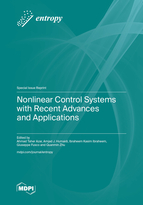Nonlinear Control Systems with Recent Advances and Applications
A special issue of Entropy (ISSN 1099-4300). This special issue belongs to the section "Complexity".
Deadline for manuscript submissions: closed (31 May 2023) | Viewed by 17095
Special Issue Editors
2. Automated Systems & Soft Computing Lab (ASSCL), Prince Sultan University, Riyadh 12435, Saudi Arabia
3. Faculty of Computers and Artificial Intelligence, Benha University, Benha 13518, Egypt
Interests: control theory and applications; robotics; process control; artificial intelligence; machine learning, computational intelligence, dynamic system modeling
Special Issues, Collections and Topics in MDPI journals
Interests: control theory; nonlinear control; robotic
Special Issues, Collections and Topics in MDPI journals
Interests: control theory; nonlinear control; robotic
Special Issues, Collections and Topics in MDPI journals
Interests: control systems: theory and applications; smart grid control
Special Issues, Collections and Topics in MDPI journals
Interests: complex dynamic system identification and control
Special Issues, Collections and Topics in MDPI journals
Special Issue Information
Dear Colleagues,
Nonlinear control, such as robust stabilization and adaptive tracking, naturally arises when dealing with nonlinear controlled systems that may be subject to a variety of uncertainties and/or time-varying disturbances. Over the last few decades, tremendous progress has been made in the development of design methodologies for the control of nonlinear systems and their applications using various mathematical tools. Because there are many important and interesting challenges, the field of non-linear control systems has a bright future. Nonlinear control applications in energy, health care, robotics, biology, and big data research will advance both theory and technology adoption.
Although the literature contains a significant number of interesting and valuable results, the synthesis of control strategies for a broader class of nonlinear systems, as well as broader applications, remains challenging and open, particularly for the diversely complicated control tasks arising from the growing integration with emerging technologies in communication and computation areas. The proposed Special Issue's main goal is to present a cutting-edge collection of articles presenting novel developments in nonlinear control approaches in both theoretical background and applications. This Special Issue covers a variety of contributions from different fields.
Prof. Dr. Ahmad Taher Azar
Prof. Dr. Amjad J. Humaidi
Prof. Dr. Ibraheem Kasim Ibraheem
Prof. Dr. Giuseppe Fusco
Prof. Dr. Quanmin Zhu
Guest Editors
Manuscript Submission Information
Manuscripts should be submitted online at www.mdpi.com by registering and logging in to this website. Once you are registered, click here to go to the submission form. Manuscripts can be submitted until the deadline. All submissions that pass pre-check are peer-reviewed. Accepted papers will be published continuously in the journal (as soon as accepted) and will be listed together on the special issue website. Research articles, review articles as well as short communications are invited. For planned papers, a title and short abstract (about 100 words) can be sent to the Editorial Office for announcement on this website.
Submitted manuscripts should not have been published previously, nor be under consideration for publication elsewhere (except conference proceedings papers). All manuscripts are thoroughly refereed through a single-blind peer-review process. A guide for authors and other relevant information for submission of manuscripts is available on the Instructions for Authors page. Entropy is an international peer-reviewed open access monthly journal published by MDPI.
Please visit the Instructions for Authors page before submitting a manuscript. The Article Processing Charge (APC) for publication in this open access journal is 2600 CHF (Swiss Francs). Submitted papers should be well formatted and use good English. Authors may use MDPI's English editing service prior to publication or during author revisions.
Keywords
- backstepping control systems
- bifurcations and bifurcating systems
- bio-inspired control systems
- fault tolerance control
- fuzzy logic control
- human–robot interaction for mobile robots
- multiple mobile robot systems
- nonlinear control design
- nonlinear analysis for AI and optimization algorithms
- nonlinear control of network-connected systems
- observer design
- output regulation and disturbance rejection
- renewable energy control systems
- robot navigation, localization and mapping
- robust control
- sensor-fusion-based control
- sliding mode control systems
- state/output feedback
- time-delayed nonlinear dynamical systems











